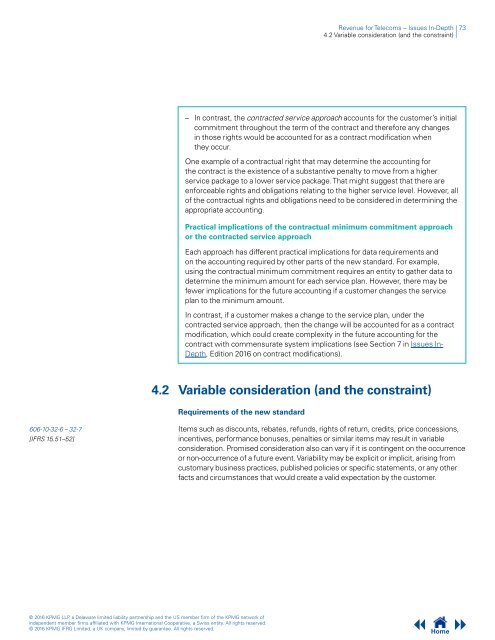Revenue for Telecoms
2cdncba
2cdncba
You also want an ePaper? Increase the reach of your titles
YUMPU automatically turns print PDFs into web optimized ePapers that Google loves.
<strong>Revenue</strong> <strong>for</strong> <strong>Telecoms</strong> – Issues In-Depth | 73<br />
4.2 Variable consideration (and the constraint) |<br />
– In contrast, the contracted service approach accounts <strong>for</strong> the customer’s initial<br />
commitment throughout the term of the contract and there<strong>for</strong>e any changes<br />
in those rights would be accounted <strong>for</strong> as a contract modification when<br />
they occur.<br />
One example of a contractual right that may determine the accounting <strong>for</strong><br />
the contract is the existence of a substantive penalty to move from a higher<br />
service package to a lower service package. That might suggest that there are<br />
en<strong>for</strong>ceable rights and obligations relating to the higher service level. However, all<br />
of the contractual rights and obligations need to be considered in determining the<br />
appropriate accounting.<br />
Practical implications of the contractual minimum commitment approach<br />
or the contracted service approach<br />
Each approach has different practical implications <strong>for</strong> data requirements and<br />
on the accounting required by other parts of the new standard. For example,<br />
using the contractual minimum commitment requires an entity to gather data to<br />
determine the minimum amount <strong>for</strong> each service plan. However, there may be<br />
fewer implications <strong>for</strong> the future accounting if a customer changes the service<br />
plan to the minimum amount.<br />
In contrast, if a customer makes a change to the service plan, under the<br />
contracted service approach, then the change will be accounted <strong>for</strong> as a contract<br />
modification, which could create complexity in the future accounting <strong>for</strong> the<br />
contract with commensurate system implications (see Section 7 in Issues In-<br />
Depth, Edition 2016 on contract modifications).<br />
4.2 Variable consideration (and the constraint)<br />
Requirements of the new standard<br />
606-10-32-6 – 32-7<br />
[IFRS 15.51–52]<br />
Items such as discounts, rebates, refunds, rights of return, credits, price concessions,<br />
incentives, per<strong>for</strong>mance bonuses, penalties or similar items may result in variable<br />
consideration. Promised consideration also can vary if it is contingent on the occurrence<br />
or non-occurrence of a future event. Variability may be explicit or implicit, arising from<br />
customary business practices, published policies or specific statements, or any other<br />
facts and circumstances that would create a valid expectation by the customer.<br />
© 2016 KPMG LLP, a Delaware limited liability partnership and the US member firm of the KPMG network of<br />
independent member firms affiliated with KPMG International Cooperative, a Swiss entity. All rights reserved.<br />
© 2016 KPMG IFRG Limited, a UK company, limited by guarantee. All rights reserved.<br />
Home







